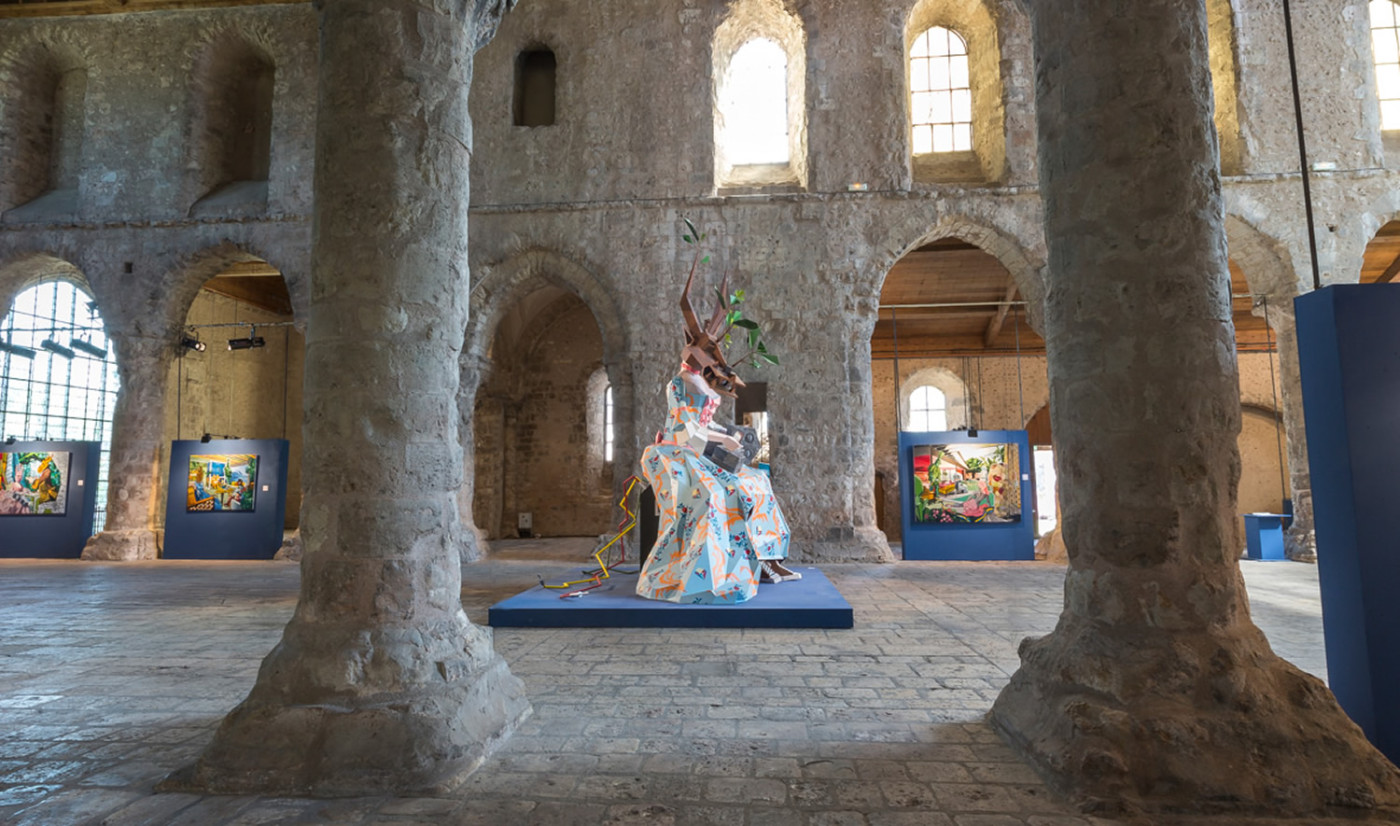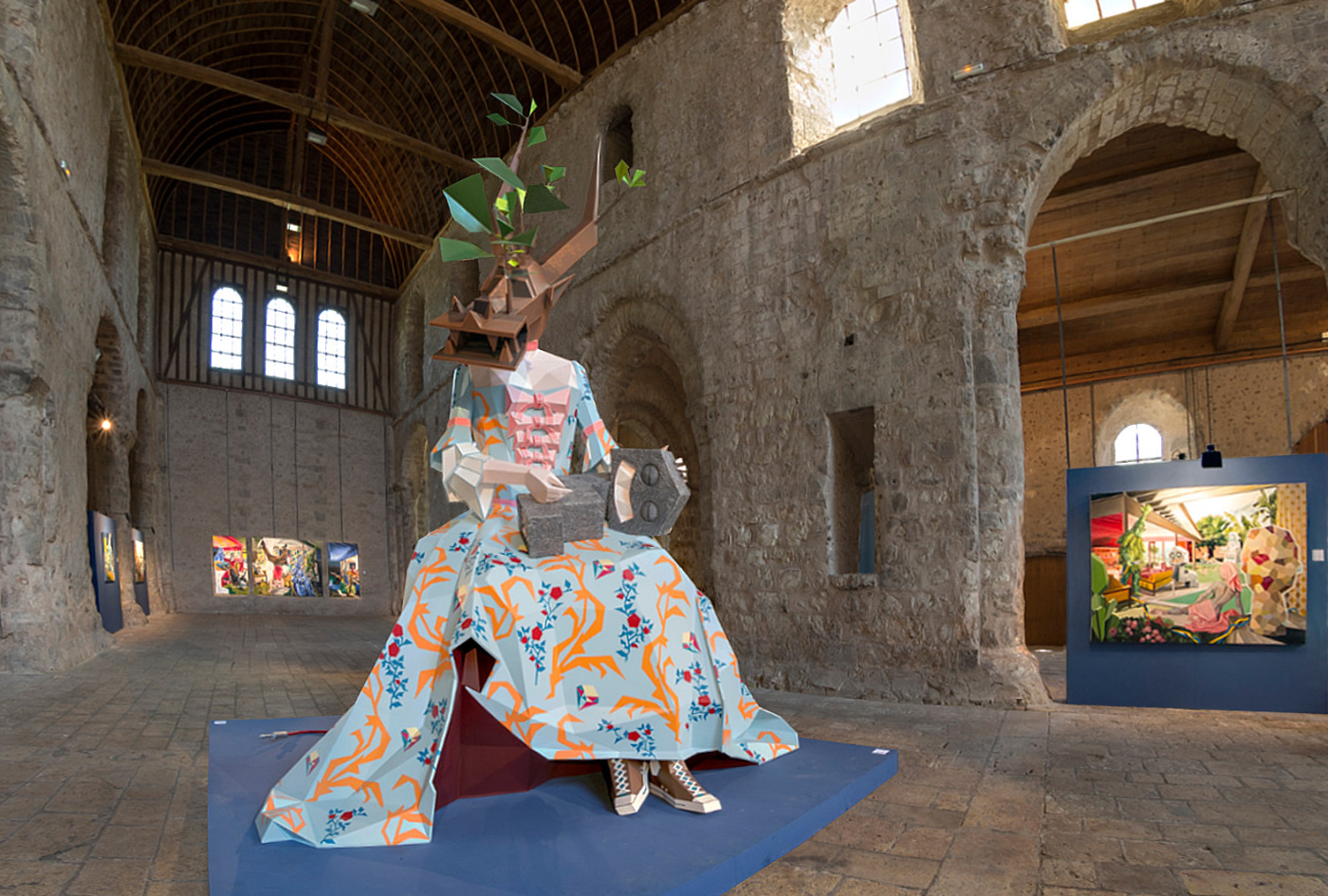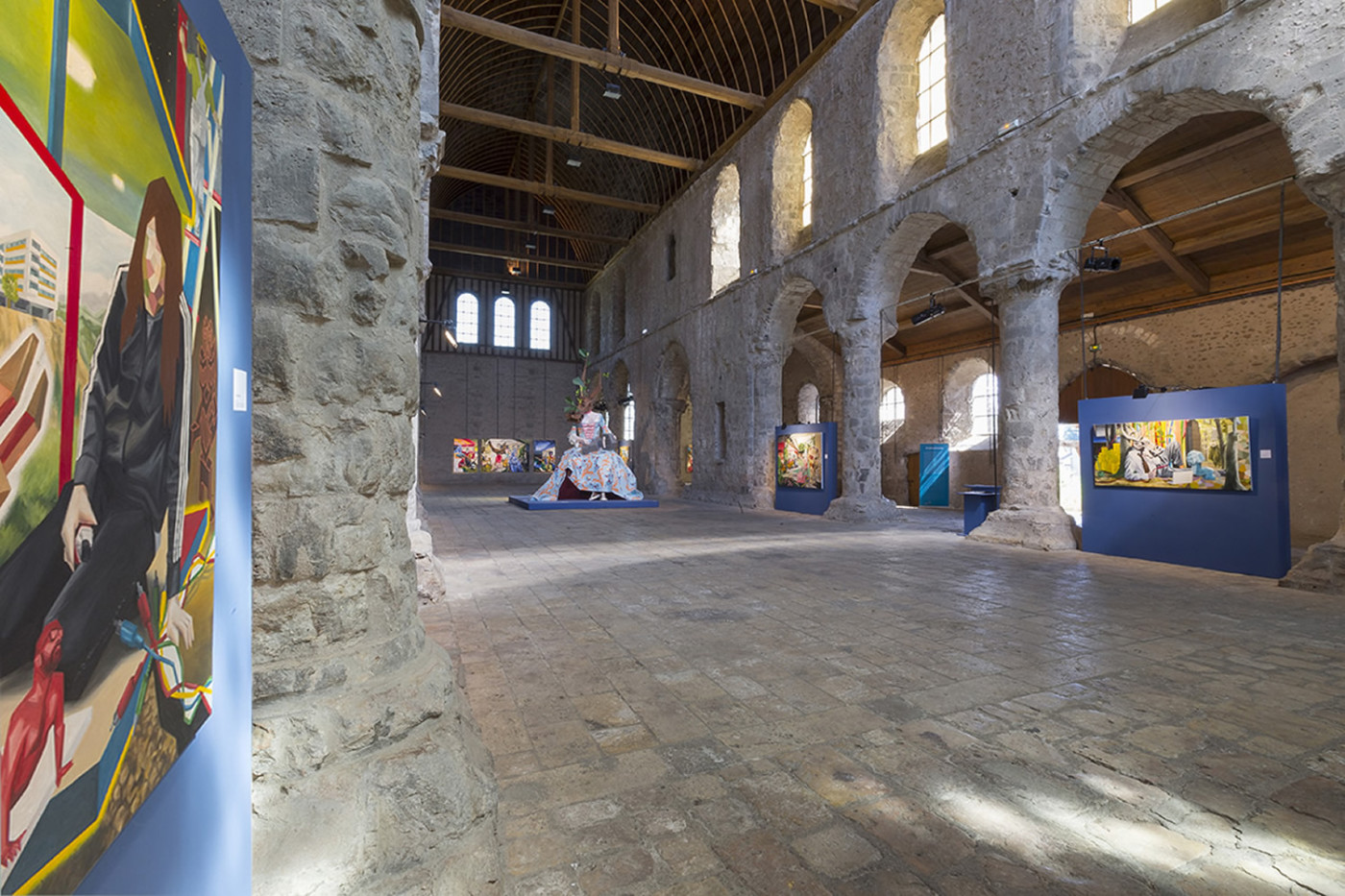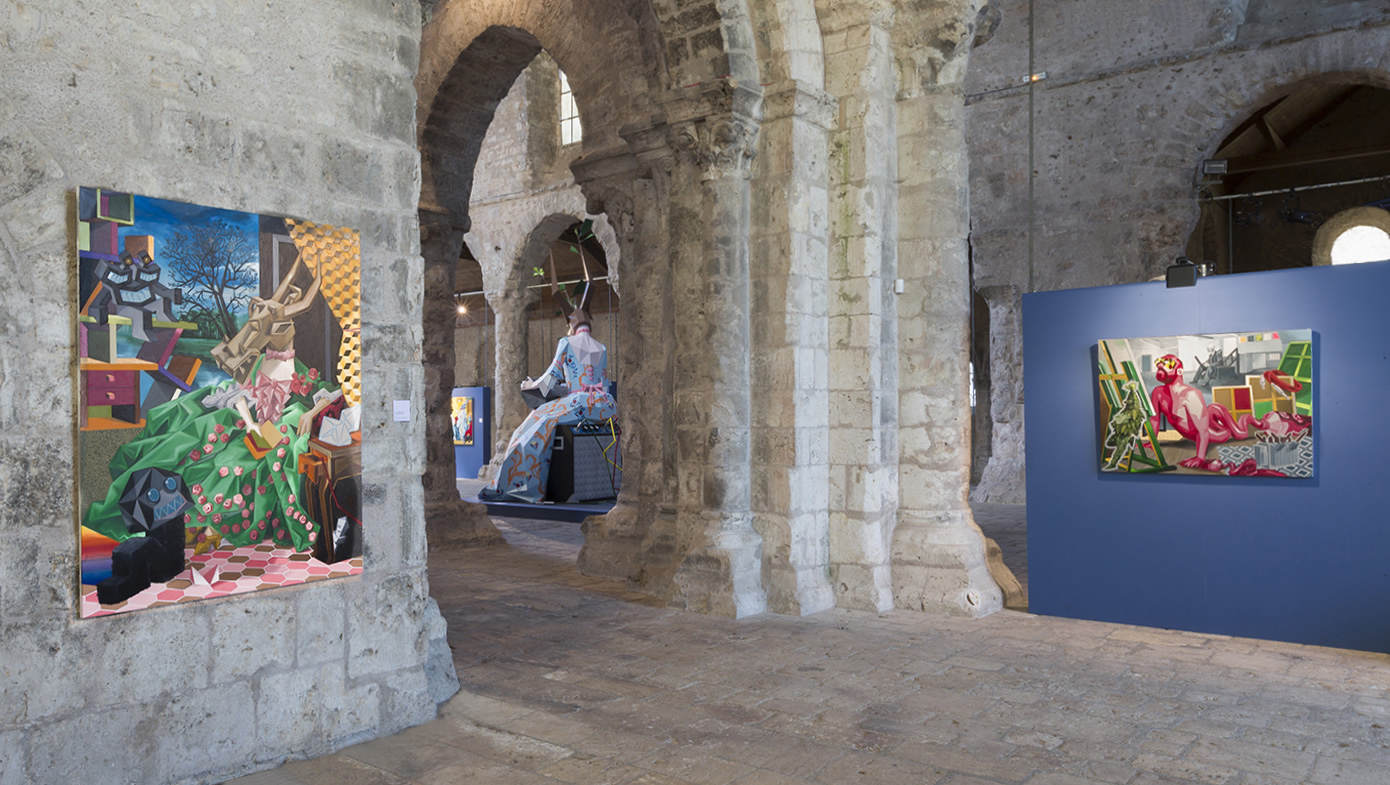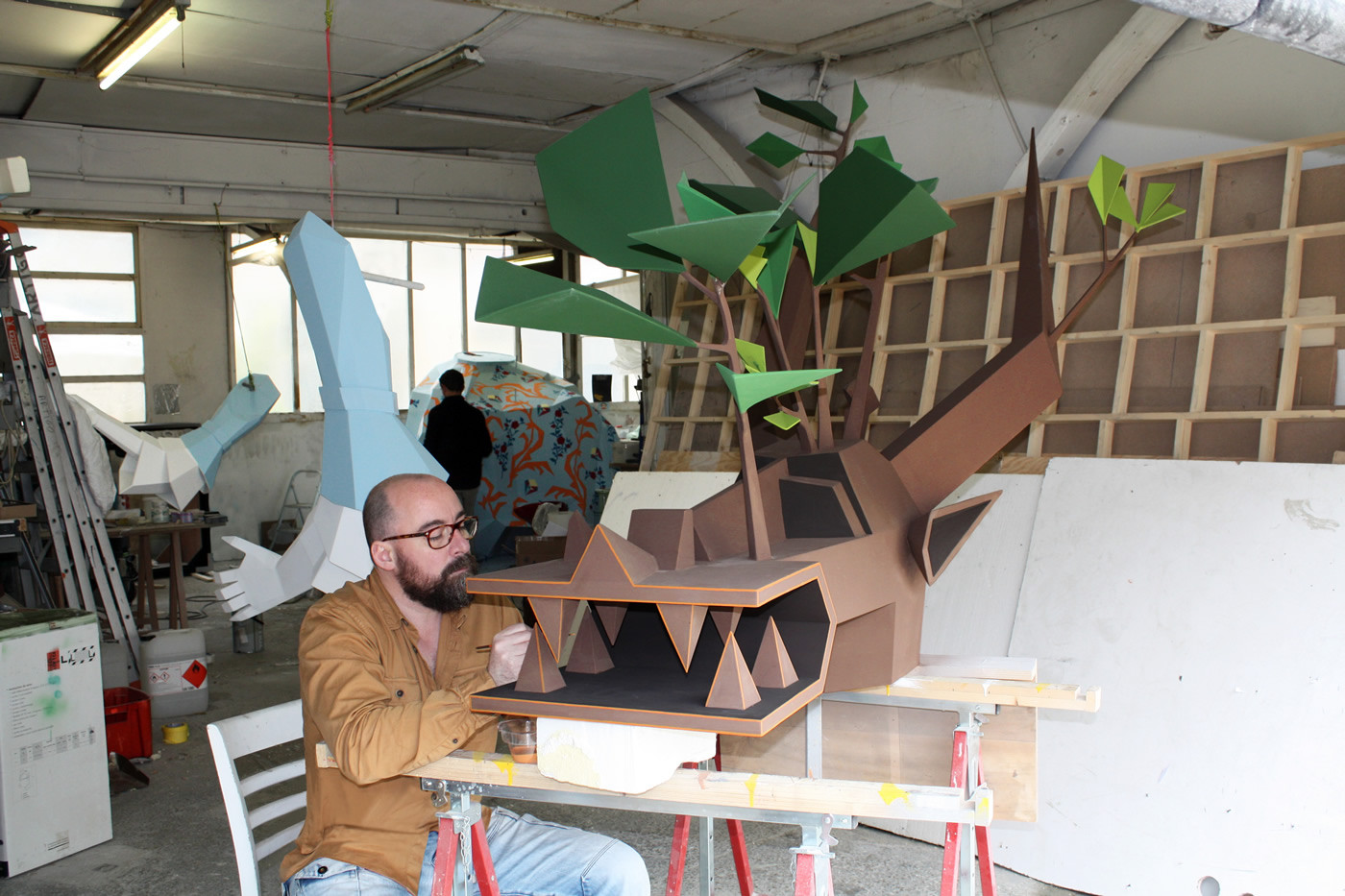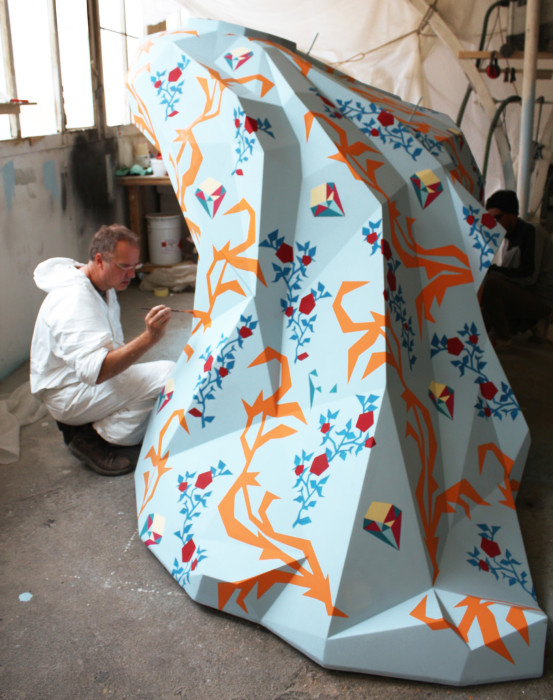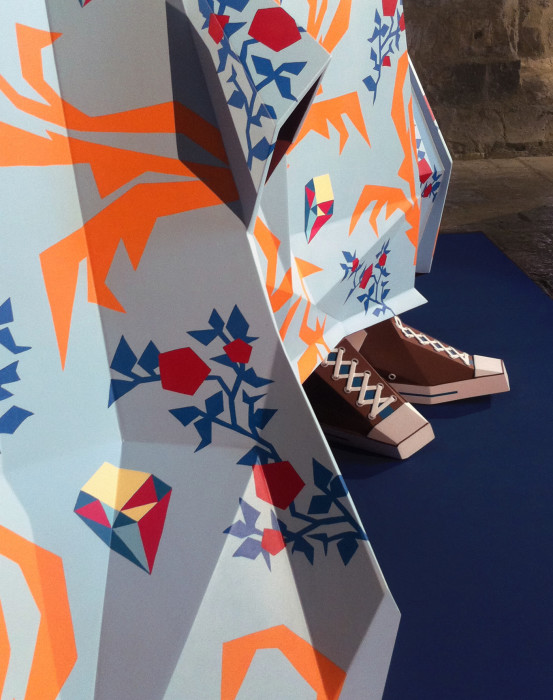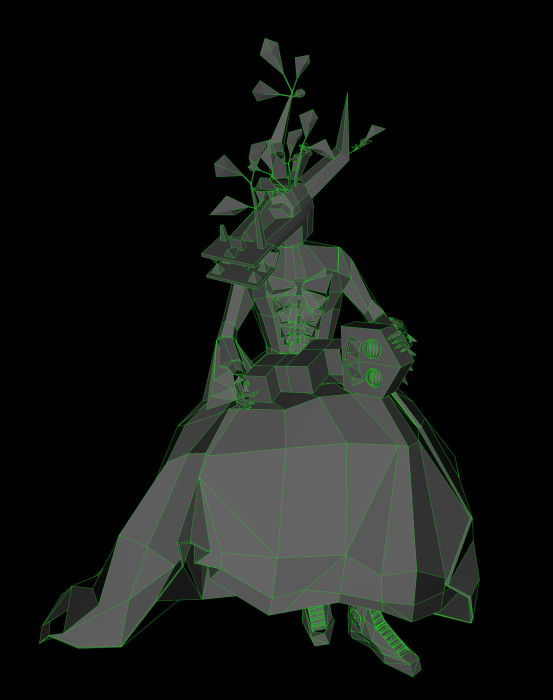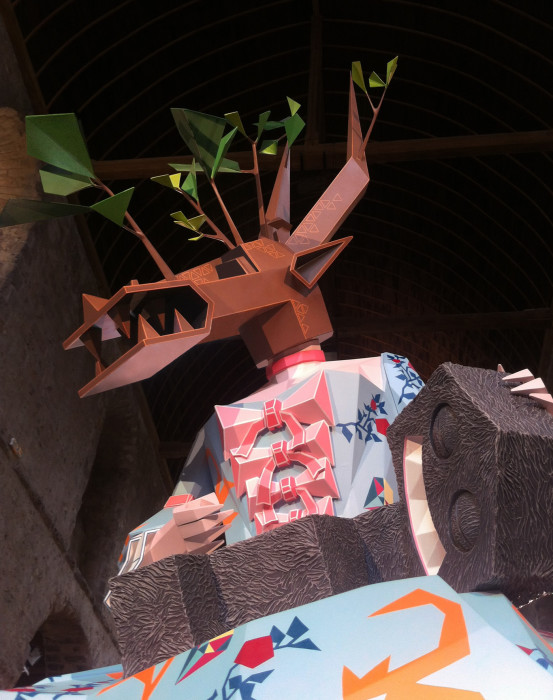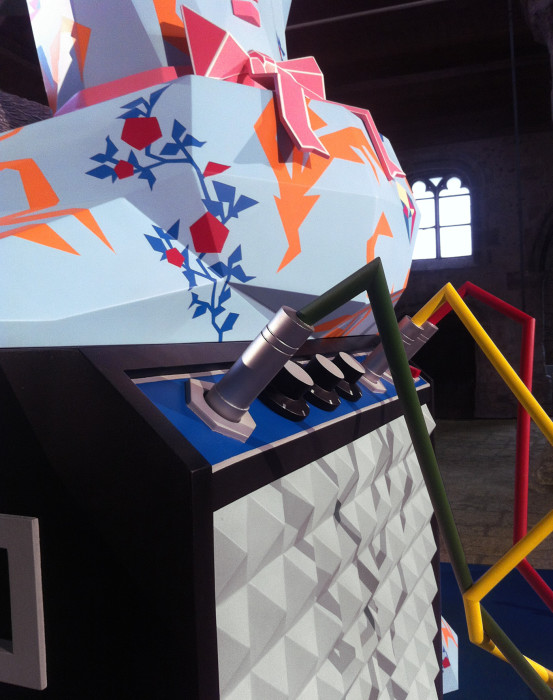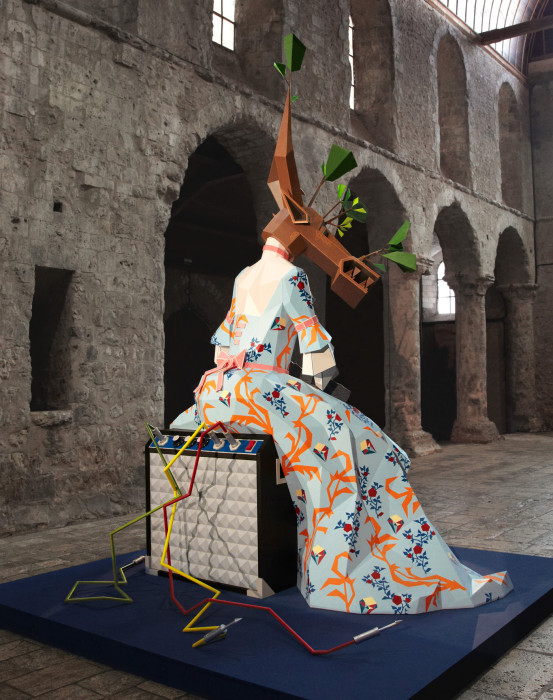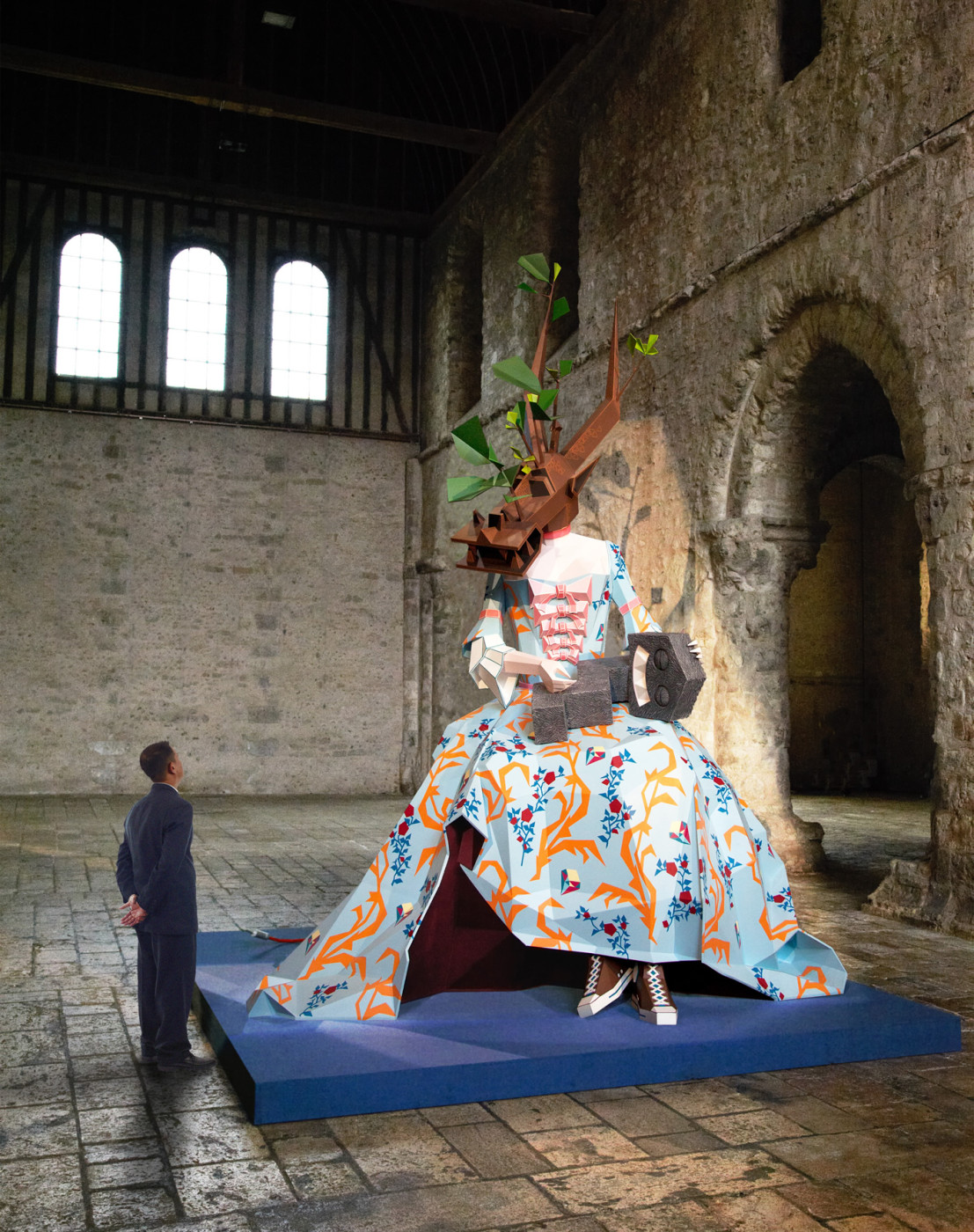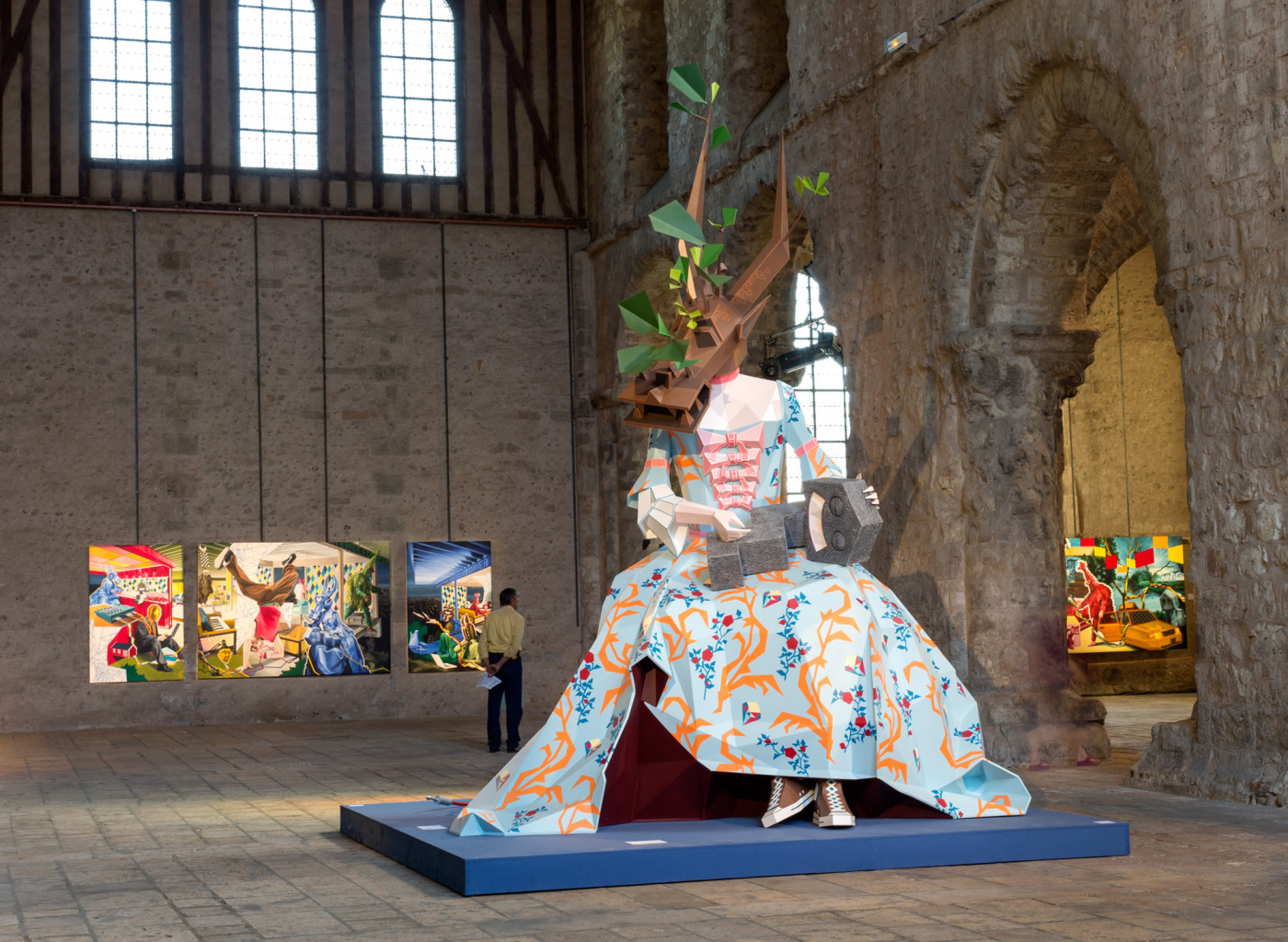
- Exhibition
MASKARADE
MASKARADE
The exhibition Maskarade is centred on a number of paintings whose recurrent theme is the mask and a monumental sculpture called Katielo. We re-discover Fuzz, a polymorphous animal, emblematic of the artist’s work, as well as several of the characters who have been present in his work from the beginning. In this latest series of pictures, Kriki brings some new characters onto the stage, characters such as Bwaba the Leaf Man, Bobo the Fibre Man, or The Songyé Pompadour and The Breakers, all inspired in African ritual, classical Western art, hip hop culture and robots with the android Topo. This surprising iconographic mixture, surprising both in its aesthetic sources as in its engagement with the reality of contemporary art, displays the originality and ambition of painting which lies on the border between Subculture and High Culture. Kriki gives precise roles to each of the figures as they emerge from the de-structured spaces of architects’ villas, open to an outside which is being constantly re-created. The presence of jacks continuously weaving through the body of work for more than twenty-five years symbolise the desire to connect all the fundamental elements of the picture with each other. The exhibition Maskarade knits Kriki’s visionary worlds together, where his own connective and pictorial language becomes a universal language.
LIKE AN ECHO… by Thierry Plantegenet
The window… A few steps from the Collegiate Church of Saint-André, in Chartres Cathedral, hundreds of stained glass windows can be seen, almost all of them inspired by the liturgy. The generous donors who, in the XIIIth century, financed the reconstruction of the cathedral, and therefore the making of the windows, were the fraternities and guilds. In return for their donations, carpenters, joiners, labourers, wine-makers, masons, stone masons, drapers, furriers and bakers are given a central place in the many scenes depicting daily life. This collection of small scale scenes provides us with a lively picture of XIIIth century society. Echoing these images drawn from the Middle Ages, Kriki provides us with another living painting, a painting drawn from the beginning of our XXIst century giving an account of his times with its symbols, clothes: robots, hip-hop culture, architect-designed villas, high-tech furniture, but also of a period rich in the mingling of cultures and respectful of its past.
Kriki tells the story of his own times in his canvases, which some might see as stained glass windows, with sharply defined close fitting shapes, playing confidently with geometric forms, perspective, depth, and playful contrasts.
Light… In this Collegial Church, the natural light (changing as the daylight hours pass) is not filtered by stained glass but enters “raw”, depending on changes in the weather…but can it change our perception of Kriki’s world? Because a different kind of light is born from his paintings, imposing itself on us, seeking to penetrate our consciousness.
L’EXPOSITION MASKARADE
L’exposition « Maskarade » s’articule autour d’un ensemble de peintures, ayant pour thème récurrent le masque, et d’une sculpture monumentale « Katielo ». On y retrouve le Fuzz, animal polymorphe, telle une marque créée par Kriki dès ses débuts , et dont le projet ambitieux autour de cette espèce en voie d’apparition sera présenté par la Galerie Kamel Mennour en 2000. Dans la dernière série de tableaux rassemblés pour « Maskarade », outre quelques personnages fondateurs de son œuvre, Kriki met en scène de nouvelles figures : « l’homme feuille Bwaba », « l’homme fibre Bobo », ou encore « La Pompadour Songyé » et « Les Breakers », autant de figures estampillées imaginaires inspirées de rituels africains, d’art classique occidental, de culture hip hop et de robotique avec l’androïde « Topo ». Cette surprenante mixité iconographique, autant dans ses sources esthétiques que dans sa prise avec la réalité de l’art contemporain, fera écrire à Ernest Van Buyender, président du Musée d’Art Contemporain d’Anvers (Muhka) : « Kriki est le seul artiste français dont l’originalité et l’ambition de sa peinture peuvent être compris comme un pont entre Subculture et Haute culture ».
A chacune de ses figures évoluant dans des espaces déstructurés de villas d’architectes, ouverts sur un extérieur sans cesse renouvelé, Kriki distribue des rôles particuliers. La présence de jacks traversant l’ensemble de son œuvre depuis plus de 25 ans, symbolise le désir de connecter tous les éléments fondamentaux du tableau entre eux. Ces représentations de câbles et fiches électroniques tressés, courant d’une peinture à l’autre, renforcent un processus esthétique donnant à penser que nous sommes là, dans de véritables connexions picturales, et non dans des collages de différents fragments plastiques entre eux. A l’évidence, l’exposition « Maskarade » met en réseau les mondes visionnaires de Kriki, où son propre langage connectique et pictural rejoint un langage universel. L’exposition devient alors ce lieu énergique où une multitude de branchements révèlent des univers singuliers, tous construits par de multiples références culturelles, et faits de la sédimentation d’affects qui jalonnent et concrétisent la vie de l’artiste.
Martine Vallée
The sculpture “Katielo” is an event, Kriki creates a spectacle! From the outset, this monumental work, specially designed and created for the Collegial Church in Chartres, sets in motion a dialogue with this historic site. It is rare to find an artist of Kriki’s generation producing such impressive sculptures for a wide public. That is why a partnership with the history of the site nevertheless at the same time provokes an inevitable debate with the history of contemporary art! “Katielo”, a name taken from the cosmogony of the Senoufo tribe in Mali, refers to the sacred mother goddess of the forest. Its message is both theological and anthropological. We should note however that the source of the sculpture’s conceptualization, the cosmogony of the Senoufos, was unknown to Kriki who at this period is attempting to radicalize his key conception of African masks whose wood is beginning to revive. This botanical term, revive, regrow makes sense by giving new life to the inert wood of which sculpted masks are made, leading to the propagation of a new idea of sullen germination to the work in each of his paintings. Powerfully immersed in Kriki’s connective sensibility, “Katielo” plays with the relationship between visible and invisible, between the mask and what lays behind. As a result, the impact of this surprise blossoming at the upper extremities extends imperceptibly over the entire sculpture, over its entire body! The unexpected and already invasive appearance of these large green leaves, of shiny new shoots, give credence to the existence of a rhizome like matrix at Katielo’s sneakered feet. Charles Péguy wrote: “Just as when flowering fails, the generative force gives up the game to begin anew from below, at the sources of the sap which are still alive…”. But “Katielo” is also a kind of identity card of someone who still represents punk culture. This strange sculpture certainly bears witness to that, where an artist crystallizes a flippant and powdered 18th century with an African Pompadour in sneakers, caressing a Fuzz asleep on its knees, as a Virgin might stroke her Child, kind and loving in a sacred and definitely solemn place, sitting on an amplifier waiting for the jacks and other Larsen effects in readiness for a concert.
It was only when searching for a name that Kriki came across the Senoufo word “Katielo”; baptised thus, this sculpture, as improbable as it is strange, slips beneath the senses in two aspects, from the plastic and from the intellectual point of view. By planting Katielo like throwing a seed into the centre of the Church, Kriki creates a stir in the possible emergence of novelty, proceeding by a process of metaphorical bifurcations in the deployment of the young leafy twigs. The inventive radicalism of the artist, combined with his way of working by a process of tree like growth by division, brings him close to the words of the philosopher Michel Serres: “Just as a branch emerges from the stem, so novelty emerges from form”. Maskarade masks nothing…
KATIELO
Martine Vallée
Avec la sculpture Katielo, Kriki donne à voir du spectaculaire et un événement se produit ! D’emblée, cette oeuvre monumentale, spécialement conçue et réalisée pour la Collégiale de Chartres force le dialogue avec ce lieu hautement élevé et historique. Il est rare de retrouver chez des artistes de la génération de Kriki, des sculptures aussi impressionnantes manifestées à un large public. Voilà pourquoi la complicité avec l’histoire de cette Collégiale datant du XIIe siècle, n’en demeure pas moins un débat forcé avec l’histoire de l’art contemporain… Katielo, nom issu de la cosmogonie Sénoufo – ethnie du Mali -, signifie la divinité-maternité consacrée de la forêt. Son message est inséparablement théologique et anthropologique. A savoir aussi qu’à la source de la conceptualisation de cette sculpture, la cosmogonie des Sénoufos est ignorée de Kriki qui, lui, à ce moment-là, cherche à radicaliser son idée-force du masque africain dont le bois se met à repousser. Ce terme botanique de repousse fait sens en donnant vie de nouveau au bois inerte des masques sculptés ; et par propagation, à l’idée d’une germination sourde à l’œuvre dans chacune de ses peintures. Fortement inscrite dans la connectique sensible de Kriki, Katielo expérimente la relation entre le visible et l’invisible, entre le masque porté et celui qui le regarde ! De ce fait, l’impact de ce surprenant bourgeonnement à ses extrémités supérieures s’étend de façon imperceptible à toute la sculpture, à tout son corps… L’apparition inattendue et déjà envahissante de ces larges feuilles vertes, de ces jeunes pousses luisantes autorisent la croyance de l’existence d’un modèle rhizomique sous les pieds baskettisés de Katielo. Charles Péguy écrit : « De même que lors d’une floraison avortée, la poussée abandonne la partie pour reprendre par en-dessous, à des sources de sèves demeurées vives… ». Mais Katielo, c’est aussi cette espèce de génome manifesté de celui qui incarne encore aujourd’hui la culture punk. En témoigne cette sculpture libre dans ses excroissances, où l’artiste cristallise un XVIIIe siècle poudré et désinvolte avec une Pompadour africaine en sneakers, caressant un Fuzz aussi confiant qu’assoupi sur ses genoux, telle une Vierge à l’Enfant, bienveillante dans ce lieu sacré, définitivement solennelle et volontairement assise sur un ampli attentant le branchement des jacks et autres effets larsens prêts au concert. C’est quand Kriki lui cherchera un nom, qu’il arrivera jusqu’à Katielo chez les Sénoufos ; aussitôt baptisée, cette sculpture tout aussi improbable qu’inouïe, retombera sous le sens par deux fois, plastiquement et intellectuellement. En plantant Katielo, comme on jette une graine, au cœur minéral de cette Collégiale, Kriki fait deux fois événement dans l’émergence possible d’une nouveauté. Tout d’abord en procédant par bifurcations métaphoriques dans le déploiement des jeunes ramilles feuillues, puis dans l’externalisation du corps inchoactif de Katielo, un corps entrain de… oui, quelque chose peut advenir, Katielo est work in progress… La radicalité inventive de Kriki, combinée à sa façon de travailler par arborescence, le rapproche des propos du philosophe Michel Serres : « Comme un rameau s’élance de la tige, la nouveauté émerge du format… ». Maskarade ne masque rien.
